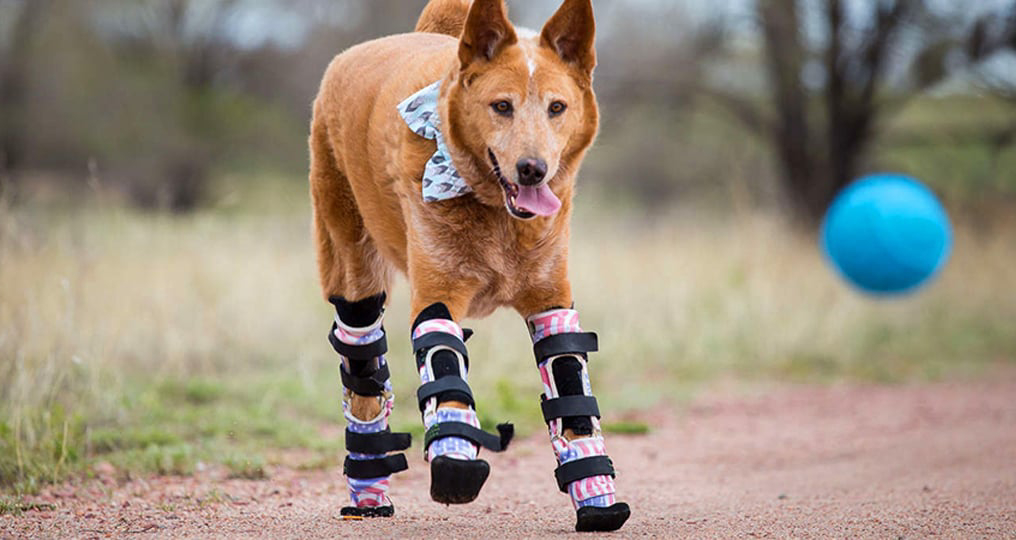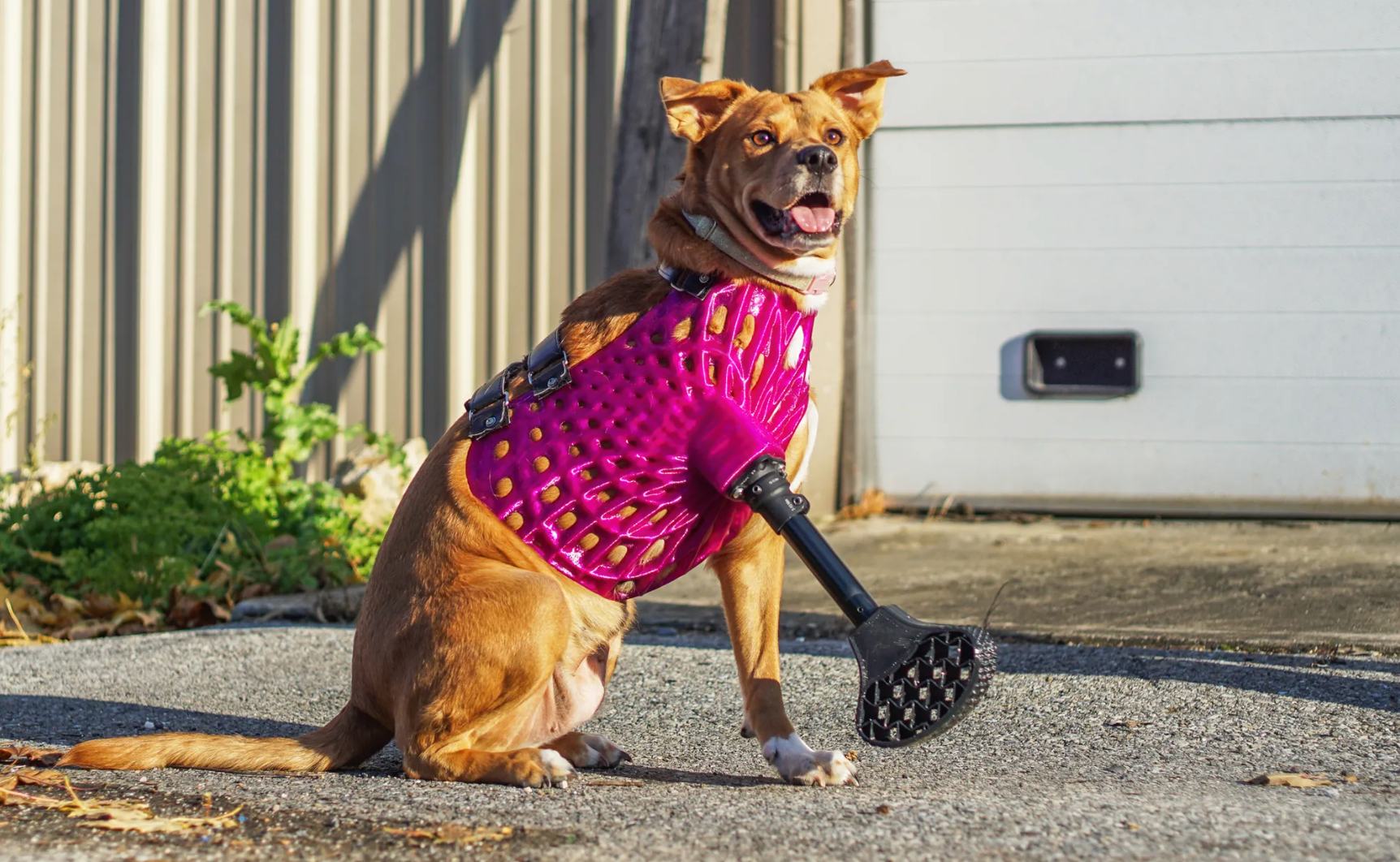In this article
View 6 More +Prosthetic limbs have been used for human rehabilitation for centuries—with some evidence dating back millennia—allowing people with severe injuries to stand, walk, and function comfortably. Though comparatively recent, this same technology is being used in veterinary medicine to help differently abled dogs run and play again.
From prosthetic limbs to full wheelchairs, the technology for animal prosthetics is evolving rapidly. Learn more about the interesting history of dog prosthetics, their uses, and how they help dogs regain their mobility.

History of Leg Prosthetics for Dogs
Some conditions require limb amputation, such as serious injuries or certain types of cancers that may affect a dog’s limbs (such as osteosarcoma, a type of bone cancer). Typically, dogs do well on just three legs if they weigh under approximately 48 pounds (22 kg), the affected leg was just amputated, and the dog adapted to their new way of living and moving around. A dog’s chances of adapting to three legs is higher if a hind leg is amputated, as dogs naturally bear more weight on their front legs than their hind legs.
However, better options slowly emerged in veterinary medicine. Dogs with partial paralysis, for example, couldn’t get by without dragging their lower body around. Wheeled carts—essentially canine wheelchairs—were used to give dogs better mobility, but they can’t replace the function of a real limb. Prosthetics were also necessary for dogs that weigh over 50 pounds (over 22 kg), as these dogs often cannot easily adapt to a 3-legged lifestyle due to the increased workload on their limbs.
The requirement for prosthetic limbs was considerably important for male dogs (regardless of their weight) when compared to both female dogs and cats of both sexes. Male dogs were often given a mid-femur amputation whenever possible; doing so would ensure their penis wouldn’t be in excessive contact with the floor after the procedure. Female dogs and cats could be given complete amputations as this wasn’t a concern for them (the anatomical location of a cat’s penis isn’t on their underside).
However, leaving a stump during the amputation process wasn’t always feasible (depending on the type of injury), and even if it were, it would increase the odds of painful surgical complications, such as the formation of neuromas 1.
As the technology evolved, prosthetics became a viable option to replace incomplete limbs and enable better mobility and quality of life. Though dogs can learn to move around with just three legs, they have to support their body differently. The imbalance can put stress on the healthy legs, leading to chronic limb pain, joint degeneration, strains, reduced mobility, and phantom pain—all of which a prosthetic can reduce.
Canine exoprosthesis, or prosthetic devices, have been around for about 40 years, but new technology options like 3D printing are greatly expanding the use cases and access for pet owners. Compared to traditional prosthetics, printed prosthetics are lightweight, affordable, and customizable.

How Does It Work?
Dog prosthetics work similarly to human prosthetics to replace missing limbs and help dogs stand, walk, run, and play normally. Each prosthetic is custom-fitted to each dog’s body to come as close to the missing limb as possible.
Like human prosthetics, dogs will need to undergo rehabilitation or physical therapy to ensure the limb fits properly and comfortably. The owner must also learn how to train the dog and show patience as they adjust to the new limb.
What Are the Different Types of Dog Leg Prosthetics?
Dog prosthetics are generally classified into three types.
- Exoprosthetic – a prosthetic worn entirely outside. These are commonly seen in front leg amputee dogs.
- Endoprosthetic – a prosthetic that’s fully enclosed within the body (such as an artificial hip).
- Endo-exoprosthetic – this prosthetic has both an external and an internal component that attach to each other. It’s most commonly used for dogs that undergo a hind-leg amputation.
Various materials may be used for dog prosthetics, including plastic polymers, thermoplastics, metal, acrylic resin, carbon fiber, aluminum, titanium, and silicone. The combination of materials depends on the prosthetic design and use, customized to the dog’s needs.
Considerations for Dog Leg Prosthetics
The process for dog prosthetics is similar to that for humans. Each prosthetic is tailored to the dog’s build, considering size, weight, height, conformation, and gait. Orthopedists study the dog’s movements and mold a limb that will move like the others to simulate natural mobility as best as possible.
The techniques for prosthetics vary significantly from manufacturer to manufacturer, but it generally involves making a plaster cast and designing the prosthetic based on images and videos of the dog. The prosthetic can then be built using plastic, metal, or other materials and refined until it’s ideal for the dog.
Not every dog is a suitable candidate for a prosthetic device, however. Age and size are important considerations, as older dogs or very small and very large dogs can encounter more challenges. If there are orthopedic problems in the limb or gait issues, the dog may not benefit from prosthetics. How much of the limb remains and the condition of the remaining joint are important considerations.
Both the dog’s personality and the owner’s commitment are factors as well. If the dog lost the limb a long time ago and has adapted fine to three legs, it may be better to leave them be. They may not accept a new device. In addition, the owner’s commitment to this dog and any other pets, their ability to work with their dog to accept the device, and their patience in following through with rehabilitation should be considered.
Advantages of Dog Leg Prosthetics
Fitting a dog leg prosthetic with a missing limb has numerous advantages, including:
- Improving mobility
- Improving quality of life
- Reducing the risk of pain, strain, or injuries to remaining legs
- Helping dogs learn to move normally after an amputation
- More natural use than a wheeled cart
Disadvantages of Dog Leg Prosthetics
While the technology is promising, there are drawbacks to dog leg prosthetics, including:
- Expensive
- Time-consuming process
- Possible quality issues with different manufacturers
- Invasive surgery with endo-exoprosthetics
- Learning curve for both owner and dog to use the prosthetic properly
- May require size adjustments and trial and error before a perfect fit can be found

Frequently Asked Questions (FAQ)
How much does a dog prosthetic cost?
The costs of a dog prosthetic can vary widely depending on the dog’s size, the limb, the manufacturer, the materials, and the design process. Many devices cost between $600 and $3,000, though they can be much more. There may also be additional costs for surgery and rehabilitation. The price may vary considerably depending on where you stay and the extent of coverage offered by your pet’s insurance provider.
Do 3-legged dogs always need prosthetics?
No, not necessarily. Some dogs live long, healthy, and happy lives with just three legs, and not all dogs are ideal candidates for prosthetics. However, the right candidates can see an improvement in mobility, comfort, and quality of life.
How long does it take to get a dog leg prosthetic?
The timeframe for a prosthetic can vary depending on the type of prosthetic, the affected limb, the dog’s size, and the rehabilitation process. The design process itself can take weeks or months; it may take months to adapt to the new limb and learn to move comfortably. If surgery is involved, the process can be much longer.

Conclusion
Dog leg prosthetics are a relatively new development in veterinary medicine and help dogs with missing limbs regain their mobility. While this can be promising for dogs after amputation, not all dogs are a good candidate for a prosthetic leg. There are many factors to consider, so it’s important to work with your vet to determine the best course of action for your dog’s quality of life and well-being.
- Related read: Why Does My Dog’s Leg Give Out?
Featured Image Credit: Property of Dive Design. All rights reserved to the copyright owners.





















2 Responses
Hello, do you have any articles on the comment on male dogs requiring a prosthetic more than a female dog or cats, i am doing a research project on animal prosthetics and would like to read into this more
Hi Ella! Thank you for your question! Based on insights shared by the veterinarian fact-checking the article, male dogs may indeed have unique challenges with amputation and prosthetic support compared to female dogs or cats. Here are some factors influencing this:
– Anatomical location of the penis: In male dogs if a complete coxofemoral joint disarticulation is performed, it would increase the risk of abrasions. This is less of an issue for male cats due to the location of their penis. Traditionally, mid-femur disarticulations were used in male dogs to minimize these concerns, although prosthetics are now often preferred due to improved technology and outcomes.
– Behavioral Factors: Many male dogs also have a preference on which hind leg they raise to pee, so a prosthetic can also help with patient aftercare & welfare if they were used to lifting the leg that is going to be amputated.
– Weight Distribution: A weight of around 22-23 kg seems to be the cut off for where dogs cannot easily move on just 3 legs. In many dog breeds, a male is often heavier than a female of the same breed/age & as such might not be physiologically able to walk on 3 legs if they are naturally too heavy.
This information is based on veterinary insights and experience with similar cases, and we hope this clarifies some of the factors involved in prosthetic choices for male dogs!